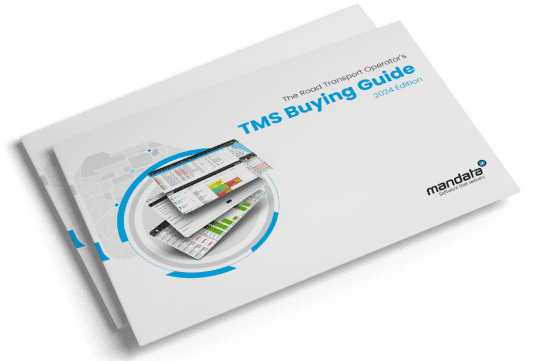The Transport Manager’s Guide to Crafting a Compelling Business Case for Transport Management Software
In today’s fast-paced business environment, the continuous enhancing of logistics operations are crucial for maintaining a competitive edge – especially using technology. One key tool that can revolutionise transport operations is a Transport Management System (TMS). However, gaining executive buy-in for such a significant investment requires a well-crafted business case that clearly communicates the value proposition and return on investment.
In this article, we will guide you through the process of building a persuasive business case to secure executive support for implementing a Transport Management System.
Understanding the current challenges
Begin by conducting a thorough assessment of your current transport and logistics process challenges. Identify pain points such as inefficient route planning, high transport costs, delayed deliveries, and poor visibility over live jobs and real-time data. Quantify the impact of these challenges on your people’s productivity and bottom line and this will provide a solid foundation for illustrating the need for a TMS. Here’s some possible questions to think about and challenge your internal processes:
- How long is it taking your planners to create and book in jobs?
- Is it difficult to plan efficient routes that are both cost and fuel efficient?
- Can your business easily view live status of jobs and assets in real-time?
- How effective is your business’ communication channels?
- Are paper proof notes slowing down your cash flow into the business?
- What financial impact does lost PODs have on your business?
- Are you able to calculate the profit/loss margin easily of each job undertaken?
Aligning needs to the business objectives and goals
Clearly outline the specific objectives and goals the TMS software aims to achieve. These could include reducing costs, improving delivery times, enhancing visibility into the supply chain, and overall speeding up order to cash-flow cycle. Align these goals with the overall strategic objectives of the organisation, demonstrating how the TMS supports broader business objectives.
Quantify the benefits
Provide a detailed analysis of the anticipated benefits that the TMS system will bring to the organisation. This may include cost savings through efficient route planning, reduced fuel consumption, eradication of empty running, and improved resource utilisation. Highlight potential revenue increases through enhanced customer satisfaction and order fulfilment. Use real data wherever possible to support your projections.
Not only could you quantify the benefits where numbers are concerned, but this could also have a positive impact for office staff using cutting edge technology that will empower them to get the job done efficiently and productively.
Although the haulage industry is typically technology averse, by gaining colleague buy-in and investing in new technology, it gives your business the opportunity to upskill and further enhance their work experience, creating a best-in-class workforce.
Financial analysis
With the help of your finance team, create a comprehensive financial analysis that outlines the total cost of ownership (TCO) for implementing and maintaining the TMS. Include training fees, any operational expenses, and potential cost savings. Use financial metrics such as Return on Investment (ROI), with the help of your possible software provider, to help provide tangible metrics where
Risk assessment
Acknowledge potential risks associated with implementing a TMS and present a mitigation plan. Executive teams appreciate thorough risk assessments, and being transparent about potential challenges demonstrates a thoughtful and comprehensive approach to help make the most informed decision. Address concerns related to technology integration, change management, and potential disruptions during the implementation phase and how you manage to get wider-business buy-in from the possible tech averse members of the business.
Industry trends and benchmarks
Demonstrate awareness of industry trends and benchmarks by including relevant market research. Highlight how competitors or industry leaders have benefited from implementing a TMS. This helps to position the investment as a strategic move to stay ahead in a competitive landscape. Not only will this gear you up to become a trailblazer in the industry, but having the best Transport Management System implemented can give you the tools to work towards or maintaining FORS accreditation.
Scalability and futureproofing
Emphasise the scalability and future-proofing aspects of the chosen TMS. Illustrate how the system can adapt to the evolving needs of the organisation and the industry. This ensures that the investment will continue to deliver value over the long term, as well as having the robust system and security in place to best tackle every growing cyber-security risk, that may even have larger impending risks if software isn’t implemented within businesses.
Change management plan
Outline a comprehensive change management plan to address the organisational shifts required for successful TMS implementation. Clearly define roles and responsibilities and communicate how the organisation will support employees through the transition. Highlight training programs and ongoing support mechanisms that internal staff can leverage as well as appointing internal training champions, so as new staff join the business, the knowledge will be continuously passed on.
Use case studies
Speak to businesses of similar sizes, or even within the same sector and ask for their opinion and experience with the chosen brand, product capability and ability to be agile with said software provider.
Executive summary
The executive summary serves as a quick reference for busy decision-makers. Compile all the key elements of your business case into a concise executive summary. This should include an overview of the current business challenges, the TMS objectives, anticipated benefits, financial analysis, risk assessment, industry trends, and the change management plan.
Building a robust business case for a Transport Management System is a strategic endeavour that requires a thorough understanding of both the organisation’s current state and its future objectives. By presenting a compelling case that aligns with business goals, gives clear benefits, and addresses potential risks, you increase the likelihood of gaining executive buy-in.
A well-supported business case not only secures approval for the TMS investment but also lays the groundwork for a successful implementation that delivers tangible and sustainable business value.

